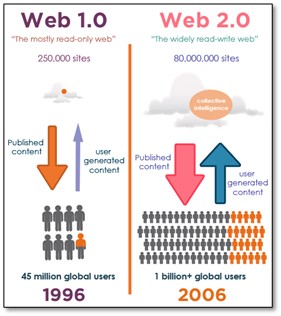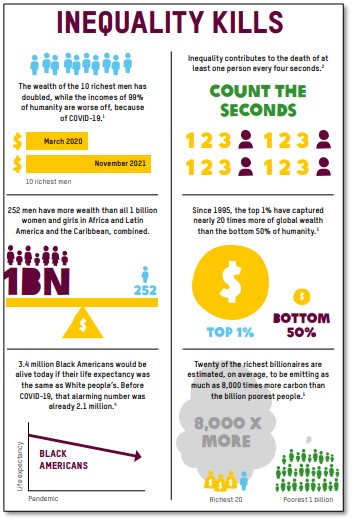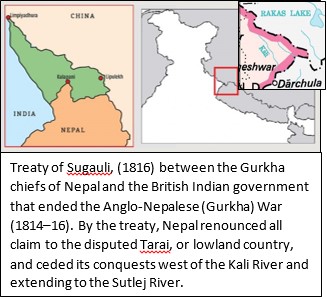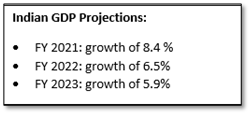Thursday, 20th January 2022
The Special Marriage Act
In News
The Special Marriage Act (SMA), 1954, the law that governs inter-faith marriages in India, has been challenged before the Supreme Court.
About the News
- A petition in the Nandini Praveen vs. Union of India, 2021 has sought the striking down of few provisions of SMA. This is because,
- Section 5 of the SMA requires a person marrying under this law to give a notice of intended marriage
- Section 6(2) says that the notice should be affixed at a conspicuous place at the office of the marriage officer and
- Section 7(1) allows any person to object to the marriage within 30 days of the publication of the notice.
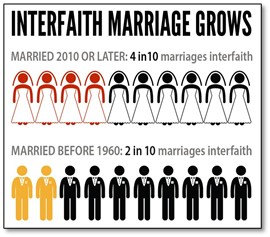
- These provisions seem to violate the right to privacy, and the right to marry.
- Besides the provisions, some State governments have been overzealous in implementing the law.
- For instance, the Haryana government has a checklist for marriages under the SMA, with 16 criteria that require a couple to publish a notice inviting objections in a newspaper and such notices would be sent to their parents.
- The Maharashtra government publicly shares the details of these couples on its website, from where communal elements can access them and start threatening the couples.
- Some States require couples to also seek a no-objection certificate from their parents.
- But even without such over-reach, several other provisions in the law seem to put the lives of these couples in grave danger.
Understanding the Special Marriage Act (SMA), 1954
- All marriages in India are registered under the Hindu Marriage Act, 1955, Muslim Marriage Act, 1954, or under the Special Marriage Act, 1954 and it is the duty of the judiciary to ensure that the rights of both the husband and wife are protected.
- Origin of SMA: The Act originated from a piece of legislation proposed during the late 19th century.
- Provisions: It is an Act of the Parliament of India with provision for civil marriage for people of India and all Indian nationals in foreign countries, irrespective of religion or faith followed by either party.
- Applies to: It extends to the whole of India except Jammu and Kashmir and applies also to citizens of India domiciled in the territories to which this Act extends who are in the State of Jammu and Kashmir.
- Features:
- A marriage under this Act allows people from two different religious backgrounds to come together in the bond of marriage.
- The Special Marriage Act lays down the procedure for both solemnization and registration of marriage, where either of the husband or wife or both are not Hindus, Buddhists, Jains, or Sikhs.
- According to this Act, the couples have to serve a notice with the relevant documents to the Marriage Officer 30 days before the intended date of the marriage.
Source:
New rules to rank SEIAA of all states
In News
The Union Ministry of Environment, Forests and Climate Change (MoEFCC) has decided to incentivise states by ranking them on the basis of efficiency and timelines in grant of environmental clearances.
State Environment Impact Assessment Authority (SEIAA)
- The SEIAA is constituted by the Central Government, which consists of three Members including the Chairman and Member Secretary to be nominated by the State Government.
- While expert committees constituted by the MoEFCC grant environmental clearance to major ‘Category A’ projects like highways, those below a certain size are appraised by SEIAA including mining, thermal plants, river valley and infra projects, except in case of huge projects.
- State authorities carry out the bulk of the Environmental Impact Assessments for proposed projects in the country.
New Rules for ranking of SEIAA of each state
These rules are primarily aimed at improving the “ease of doing business’’, especially in the context of “ranking of states based on the time taken in according clearances”.
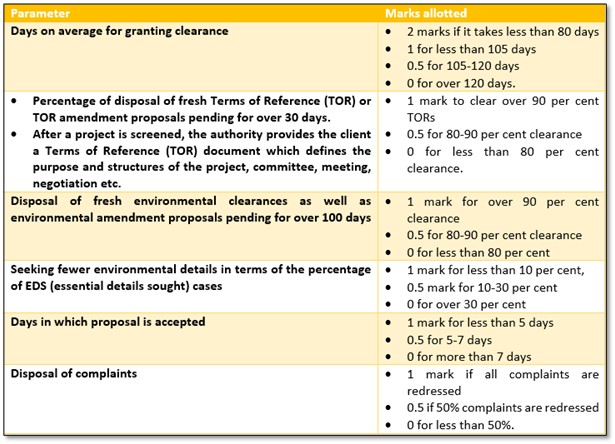
- Based on these parameters, if an SEIAA gets more than 7 marks, it will be ranked as 5-star (the highest ranking).
- The state authorities can be ranked as 5,4,3,2 and 1-star, depending on their cumulative score.
- Any SEIAA which gets a total of less than 3 marks will get no star.
Concerns regarding the marking system
- SEIAA, whose mandate is to ensure protection of the environment, will now “compete’’ to clear projects swiftly, to increase state rankings. It will affect the functioning of authorities in ecologically fragile regions.
- The SEIAAs give over 90 per cent clearances across the country, primarily for construction projects. With rising air pollution, granting swifter clearances will be detrimental.
- The World Bank itself has discounted the principle of ease of doing business, admitting that it does not work.
- The time period for providing environmental clearance to a project was already reduced from 105 days to 75 days in order to streamline clearance processes. This additional incentive may not provide any improvement.
Sources:
PM MITRA
In News
The government has released operational guidelines for PM Mega Integrated Textile Region and Apparel (PM MITRA) parks scheme.
About PM-MITRA
- Ministry of Textiles (MoT) launched PM MITRA to help India in achieving the Sustainable Development Goal 9 to build resilient infrastructure, promote sustainable industrialization and foster innovation.
- It is inspired by the 5F vision of Farm to Fibre to Factory to Fashion to Foreign.
- The scheme will develop integrated large scale and modern industrial infrastructure facility for total value-chain of the textile industry for example, spinning, weaving, processing, garmenting, textile manufacturing, processing & printing machinery industry.
- The scheme envisages to leverage Public Private Partnership model for fast paced implementation in a time-bound manner.
What are the important operational Guidelines under PM-MITRA?
- Five Metrics: As per the guidelines, the sites for the parks will be selected basis five metrics- connectivity to site, existing ecosystem for textiles, availability of utilities services at site, state industrial /textile policy, and environmental and social impact.
- Mega-parks: Parks to be set up on the basis of proposals received from State Governments having ready availability of contiguous and encumbrance-free land parcel of minimum1000 acres.
- Setting-up of SPV: State Government to transfer land to the Special Purpose Vehicle (SPV) at notional price. It will be a legal entity with 51% equity shareholding of State Government and 49% of Central Government.
- Selection: The selection of PM MITRA Park sites will be done in a two-stage selection process on Challenge Method. Selected sites will be released Grants in Aid from MoT for infrastructure development/ construction of PM MITRA parks based on the approved DPR/Master Plan.
- Funding & Release of Grant: The Scheme has a budget outlay of Rs. 4445 Crore including administrative expenses of Rs 30 crore over 7-year period up to 2027-28.
- Development Capital Support (DCS): The Central Government will provide DCS in the form of Grant in Aid (Capital) to the Park SPV for creation of Core Infrastructure. It will be provided in two Phases for Greenfield Park and Brownfield Parks with concession period of 25 years.
- Competitive Incentive Support (CIS): Incentive to be provided to manufacturing units up to 3% of the total sales turnover to the unit established in the PM MITRA Park to reduce its cost and offset its disadvantages to a certain extent.
- The CIS will be fund limited and will be available on a first-come-first-serve basis.
- The incentives will only be available to those manufacturing companies who are not availing benefits of Production Linked Incentive (PLI) for textile scheme.
- Project Monitoring: MoT to appoint a Project Management Agency (PMA) which will act as the Technical Support for periodically monitor the progress of the projects under the Scheme.
- Project Approval Committee (PAC): Proposals to be approved by the Project Approval Committee comprising of stakeholders including Secretary Textiles and representatives of NITI Aayog.
Sources:
Khan Abdul Ghaffar Khan
On January 30, 1988 Khan Abdul Ghaffar Khan, also known as Frontier Gandhi, died due to long illness. He was a Pakhtun or Pathan from the North West Frontier Province, now called Khyber Pakhtunkhwa. He led a non-violent movement against the British in the province. Ghaffar Khan embraced the Gandhian philosophy of non-violence because it resonated with Islam. The founder of the Khudai Khidmatgar, he resorted to non-violent means of activism against colonial rule and later settled in Pakistan following the Partition of India. Khan was opposed to the Partition and was frequently jailed or exiled by the Pakistan Government for opposing its policies in the 1960s and 1970s. The Indian Government awarded Khan the Bharat Ratna in 1987. A member of the Indian National Congress, Khan formed a close association with Gandhi. He was vehemently opposed to the Partition of India and sided with the Congress and against the All India Muslim League
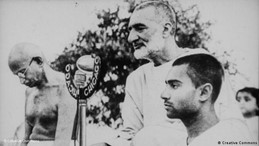
Sources:
Indian Agriculture: Achievements and Challenges
In News
The Reserve Bank of India released an article titled 'Indian Agriculture: Achievements and Challenges'.
Introduction
- With the first generation Green Revolution, India has become a global agricultural powerhouse.
- Today, India has emerged as the world’s largest producer of milk, pulses, jute and spices, and has the world’s largest cattle herd (buffaloes). India ranks second in production of rice, wheat, cotton, sugarcane, tea, groundnut, fruits, and vegetables.
- Agriculture continues to grow in absolute terms despite its declining share in overall gross value added (GVA) of India, and employs almost 49% of the total households.
- Despite such gains, Indian agriculture continues to be characterised by issues of climate change disturbances, fragmented landholdings, low farm productivity and high food price volatility.
- The current overproduction of crops like rice, wheat and sugarcane, has led to rapid depletion of ground water table, soil-degradation and massive air pollution raising questions about environmental sustainability of current agricultural practices in India.
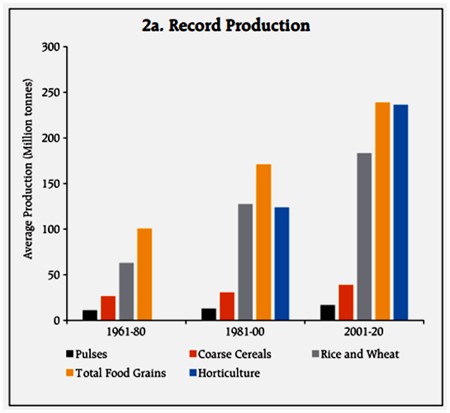
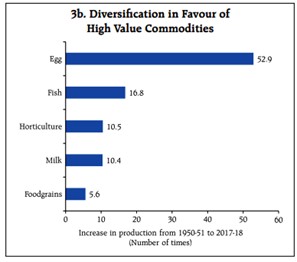
Major Achievements of Indian Agriculture
- Record Production of Foodgrains aided by higher agriculture credit, public and private investment, increased usage of quality seeds and fertilisers, expansion of acreage under irrigation and increase in cropping intensity.
- Diversification towards Horticulture Crops: Horticulture production has outpaced foodgrains production since 2012-13 and it currently accounts for around 35% of total value of crop output in the agriculture sector.
- Growing Importance of Allied Activities: With operational land holding size declining gradually, livestock is emerging as an important source of stable livelihood for not only the small and marginal farmers but also the landless labourers.
- Changing Dynamics of Agriculture Trade: Its share in global trade of agricultural and allied sector products has doubled from 1.1% in 2000 to 2.2% in 2018. The agriculture and allied sector contributed to 14.2% of the total exports from India in 2020-21.
Key Growth Enablers of Indian Agriculture
- Productivity Growth: Foodgrains productivity has grown rapidly mainly driven by rice and wheat aided by high-yielding seed varieties, investment in public research and fertiliser usage.
- In comparison to cereals, the productivity growth in case of pulses, oilseeds, nutri-cereals and horticultural crops remained sluggish. Also, crop yields in India have been only about 30- 60 per cent of that in developed countries.
- Farm Mechanization: Farm mechanization has the potential to enhance agricultural productivity by 30% and reduce the input cost by 20%. Mechanized farming also reduces the time required to complete the farm operations and softens the drudgery innately associated with agriculture labour. But the level of mechanisation is only around 40% compared to 75% in Brazil, 80% in Russia and over 90% in developed countries.
- Growing Irrigation Coverage: An irrigation potential of 126.7 million hectares has been created. The Pradhan Mantri Krishi Sinchai Yojana (PMKSY) led to increased use of micro irrigation (sprinkler and drip irrigation) ensuring water use efficiency at the farm level. But the wholly irrigated area in India is still limited to 34.4% against the wholly unirrigated area of 38.6%.
Challenges Ahead and Solutions
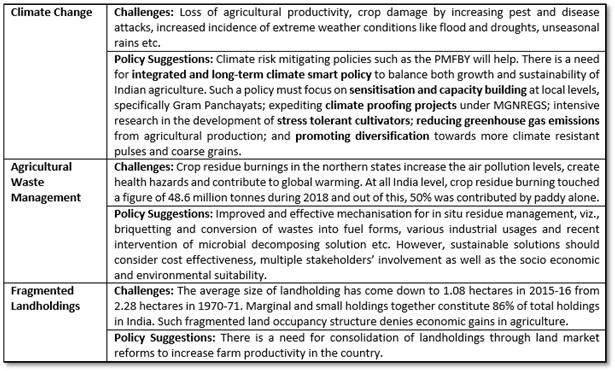
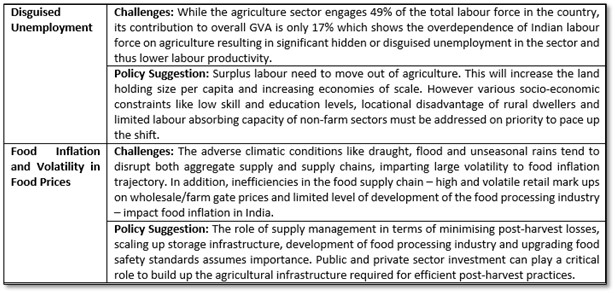
Conclusion: Addressing these challenges would require a second green revolution focused on adoption of environmentally sustainable and climate resistant new farm technology, development of market for land consolidation and improvement in post-harvest practices and a revamp of co-operative movement through formation of Farmer Producer Organisations (FPOs). This can arrest the volatility in food prices and farmers’ income and help harness the true potential of Indian agriculture.
Question: India needs the Green Revolution 2.0. Comment.
Sources:
Goat-headed Yogini
This is image of the goat-headed Yogini that went missing from India in the 1980s. This Indian idol, dating back to the 10th century, was illegally removed from a village temple in Uttar Pradesh over 40 years ago and was discovered in a garden in England. It was returned to India on the occasion of Makar Sankranti on January 14, 2022. The sculpture, which is part of a Yogini set from Lokhari Temple in Banda district of Bundelkhand, will now be dispatched to the Archaeological Survey of India in New Delhi. Yoginis are a group of powerful female divinities associated with the Tantric mode of worship. They are worshipped as a group, often 64, and are believed to possess infinite powers.
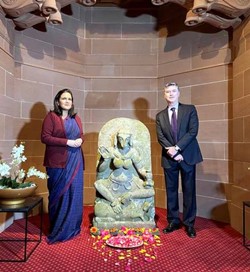
Source:
Buy now Pay Later (BNPL)
- Context: The Reserve Bank of India (RBI) has sought details of shadow banks’ BNPL arrangements with e-commerce (e-com) players.
- Buy Now, Pay Later is a type of short-term financing that allows consumers to make purchases and pay for them at a future date, often interest-free.
- It is where buyers typically get credit for a 15–30-day interest-free repayment period.
- Also referred to as "point of sale installment loans”, BNPL model is currently gaining traction especially in e-commerce as loans are being offered at 0% interest
- Since there is no interest being charged, the platforms are not required to book the loan on a NBFC or to report it to a credit bureau. Hence, no regulations are applicable to them.
- in 2020, BNPL accounted for 2.1% of global e-commerce transactions and the figure is expected to double by 2024 to around 4.2% of global e-commerce sales.
- The NBFCs which lend the BNPL loans are to be registered under the Reserve Bank of India Act, 1934.
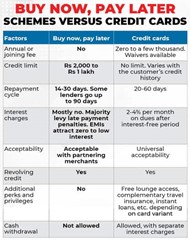
Source:
National Technical Textiles Mission
- Context: The ministry of textiles has recently cleared 20 strategic research projects on specialty fibres and geotextiles, under ‘National Technical Textiles Mission.’
- The National Technical Textiles Mission aims to develop the usage of technical textiles in various flagship missions, programmes of the country including strategic sectors.
- Technical textiles are defined as textile materials and products used primarily for their technical performance and functional properties rather than their aesthetic or decorative characteristics.
- They are used individually or as a component/part of another producte., they are used individually for specific functions such as fire-retardant fabric for uniforms of firemen and as a part of another product, to enhance the strength, performance or other functional properties of that product.
- The use of technical textiles in agriculture, aquaculture, dairy, poultry, etc. will bring:
- An overall improvement in cost economy
- water and soil conservation
- better agricultural productivity & higher income to farmers per acre of land holding
- promotion of manufacturing and exports activities in India. National Technical Textile Mission is aiming at development of indigenous machineries and process equipment for technical textiles, in order to promote 'Make In India' and enable competitiveness of the industry by way of reduced capital costs.

Source:
Open Data Week
- Context: The Ministry of Housing and Urban Affairs (MoHUA) has announced the initiation of the Open Data Week.
- This is to encourage the adoption of open data and promote innovation across India's urban ecosystem.
- It aims to show the benefits of open data such as increased efficiency, transparency, a spur in innovation, and economic growth.
- 100 Smart Cities throughout India will be participating and presenting high-quality datasets and data blogs on the Smart Cities Open Data Portal.
- The Implementation will be divided into two sets:
- Set 1: that include uploading of datasets, visualizations, APIs and data blogs on the Smart Cities Open Data Portal.
- Set 2: the celebration of a Data Day by all smart cities
- The idea is to provide a platform that offers ample opportunities that addresses complex urban issues, such as the ongoing COVID-19 pandemic.
- This can help governments in solving some of the most common problems faced by the citizens of any city and replicating the successful ideas in other cities.
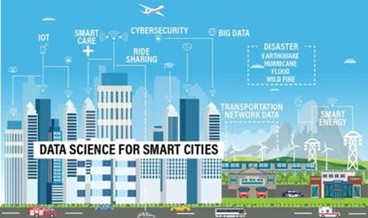
Source:
Pollution in River Yamuna
- Context: Delhi Pollution Control Committee (DPCC) have reported that pollution in Yamuna has worsened due Feacal bacteria level.
- Over 20% of the population is get a proper sewer network. Over 80% of the sewage treatment plants (STPs) do not meet standards.
- Experts stated that faecal levels were high due to poor sewage treatment and low ambient temperatures.
- The high levels of fecal coliform in the river may cause a large number of skin infections and water-borne diseases such as hepatitis, typhoid, jaundice,
- It also results in an increase in the organic matter level of the river. The decay of this organic material can easily deplete the amount of dissolved oxygen, which threatens the aquatic life that resides in the river.
- Recently, a layer of toxic foam had covered the Yamuna river in Delhi as a result of water pollution.
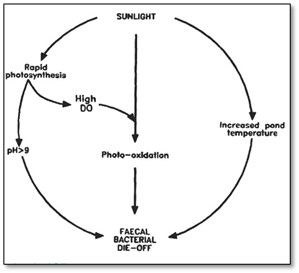
Source:
Democratise and empower city governments: TH
Essence: Recent Reports by the RBI and 15th Finance Commission have rightly pointed out the need for financial empowerment of the cities to enable them to provide better governance. While 74th amendment Act provided for 18 functions to be performed by the urban local bodies, the source of its finance was not given due attention. In facts reforms like Goods and Services tax have left them worse off by subsuming taxes like Octroi.
India should learn lessons from Kerala model and Scandinavian countries’ model where sizable percentage of tax collected by upper tiers of the government is devolved to urban bodies. Economic empowerment of the urban bodies along with empowerment of elected urban bodies armed with permanent cadre of functionaries is the way forward to make cities more responsive to challenges.
Why should you read this article?
- To understand challenges being faced by urban governance in responding to challenges like pandemic and climate change.
- To find points related to suggestions for improving urban governance.
- To find two case studies (Kerala and Scandinavian countries) on success of financial empowerment of local bodies
Source:
The mobile phone sector has lessons for India’s economy: IE
Essence: The article starts with mentioning how India and China had same per capita GDP in 1983 but by 2022, China’s GDP will be five times to that of India. The reason being strong manufacturing and export sector which has played a significant role in China’s growth. India too built on its manufacturing capabilities and India’s mobile phone manufacturing value jumped more than eight times from 2013-14 to 2020-21. But, India needs to conquer the fronts of exports and value addition too. India’s value addition in phone manufacturing is limited to 15-20 percent when compared to China.
What India needs is judicious mix of protection and incentive which could create trade surplus and be replicated to other sectors too. With advantage of large domestic market, it is time to expand manufacturing sectors and improve our market share. To attain this India would need seamless coordination between central, state and local government along with rule of law, and flexi labour laws.
Why you should read this article?
- To understand the reasons for India lacking behind in GDP growth rate.
- To understand what are the potential areas which India can channelize.
- To understand the steps to be taken to support the development in India.
Source:
The many problems of online anonymity: TH
Essence: The editorial focuses on the reasons why people choose to be anonymous and the multiple issues that arise due to the same. Anonymity- the ability to become unidentifiable with the information that we share, helps people participate in online conversations without being judged, or being tagged/mapped with their real identity, to allow them opinions along with their privacy, to vent their anger against popular authorities like the government, etc. It does provide freedom to the unknown persons but gives them an uninhibited, unchecked tool for offense.
While it is true that not all anonymous profiles are vindictive or abusive, it is also true that many of the abuses hurled, fake news shared are from such profiles. To add to it, social and digital media platforms of the day offer wider avenues for concealing one’s real identity in online space. In case of defaults on the part of such anonymous users, the only method left for the victim is legal recourse for justice against such anonymity.
Why you should read this article?
- To understand various factors which lead to an online user becoming anonymous.
- To understand how social media promotes anonymous users.
- To analyze the impacts of unchecked social digital presence of
Source:
Padmashri Dr. Viswanathan Shanta
- Background: Recently, officials at Adyar Cancer Institute, Chennai paid tributes to Mother Teresa of Cancer- Dr. Shanta.
- Shanta was a long-time supporter of early cancer screening and worked to change people’s perception of the disease, particularly its overwhelming fear.
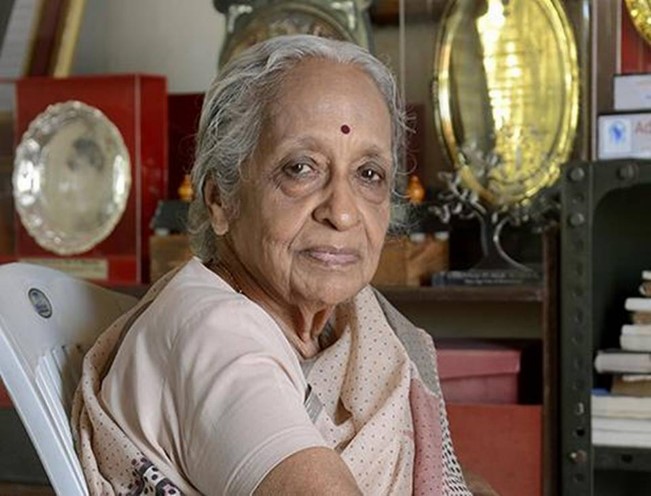
Her journey from ‘Shanta’ to ‘Mother Teresa of Cancer’
- Following her education, instead of a lucrative practice, she chose a career and life to an ordeal against cancer. She moved into the campus of the Cancer Institute in 1955 and made this her home until her last days in January 2021.
- She concentrated on building a pool of professionals and scientists at the Cancer Institute, in addition to caring for patients.
- She was a beacon of hope for patients coming from far and wide at odd hours at the Institute, seeking care and assistance.
- She introduced numerous cancer-related courses in oncology to train the future generation of oncologists as an educator.
- Shanta ensured that the Institute stays loyal to its concept of 'Service to All' in an era when specialized medical treatment in India has become increasingly commercialized.
- Services still are free or subsidized for some 60 per cent of the Cancer Institute’s 100,000 annual patients.
- She received the Padma Shri Award in 1986, Ramon Magsaysay Award in 2005, the Padma Bhushan Award in 2006, and the Padma Vibhushan Award in 2016.
Quote: “The best way to find yourself is to lose yourself in the service of others" — MAHATMA GANDHI
Source:
Share the article
Get Latest Updates on Offers, Event dates, and free Mentorship sessions.

Get in touch with our Expert Academic Counsellors 👋
FAQs
UPSC Daily Current Affairs focuses on learning current events on a daily basis. An aspirant needs to study regular and updated information about current events, news, and relevant topics that are important for UPSC aspirants. It covers national and international affairs, government policies, socio-economic issues, science and technology advancements, and more.
UPSC Daily Current Affairs provides aspirants with a concise and comprehensive overview of the latest happenings and developments across various fields. It helps aspirants stay updated with current affairs and provides them with valuable insights and analysis, which are essential for answering questions in the UPSC examinations. It enhances their knowledge, analytical skills, and ability to connect current affairs with the UPSC syllabus.
UPSC Daily Current Affairs covers a wide range of topics, including politics, economics, science and technology, environment, social issues, governance, international relations, and more. It offers news summaries, in-depth analyses, editorials, opinion pieces, and relevant study materials. It also provides practice questions and quizzes to help aspirants test their understanding of current affairs.
Edukemy's UPSC Daily Current Affairs can be accessed through:
- UPSC Daily Current Affairs can be accessed through Current Affairs tab at the top of the Main Page of Edukemy.
- Edukemy Mobile app: The Daily Current Affairs can also be access through Edukemy Mobile App.
- Social media: Follow Edukemy’s official social media accounts or pages that provide UPSC Daily Current Affairs updates, including Facebook, Twitter, or Telegram channels.

